| |
|

|
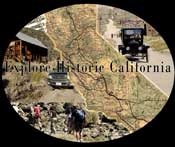
|
|
|
TOUR INFORMATION |
|
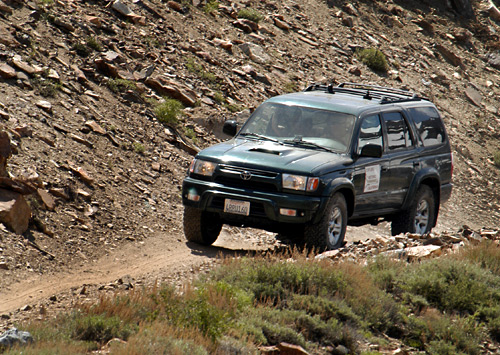 |
|
Sky high gas prices along with
sluggish economic conditions have severely impacted our tour
business for over a year.
We have reluctantly decided to
suspend our tour operations for the time being.
Our sincere thanks and appreciation to
all who continue to support us. |
|
|
LOGO T Shirts Available
 |
|
Explore Historic California with our logo depicting the
California backcountry and its rich history both true and
farce. |
|
We now offer
shirts, sweats, jerseys and cups with our logo. |
|
Click the shirt for details! |
|
|
|
 |
 |
|
Friends
of Last Chance Canyon is a new organization interested in
sustaining and protecting areas within the El Paso
Mountains, near Ridgecrest, California. The main focus is
preserving and protecting historic sites like Burro
Schmidt's tunnel and the Walt Bickel Camp.
Please click
on either logo to visit the FLCC site. |
|
|
We
support |
|
 |
|
|

Bodie Foundation
"Protecting Bodie's Future by Preserving Its Past
JOIN US FOR THE ANNUAL FRIENDS OF BODIE DAY HERITAGE
CELEBRATION
SATURDAY,
AUG. 14, 2010
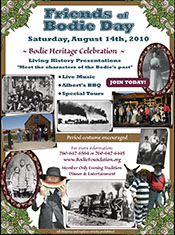
|
|
|
|
|
 |
|
This month marks the anniversaries of Beverly Mason's death
(Aug. 7) and Room 8's death (Aug. 13).
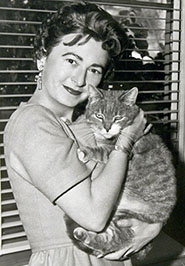
Remember them by supporting Room 8's charitable legacy with
a donation to the Room 8
Memorial Cat Foundation or adopting one of their cats. |
|
Click on Room 8's
photo or phone
951-361-2205
for more information. |
|
|
 |
|
 |
|
Mules can
taste the difference--so can you |
|
|
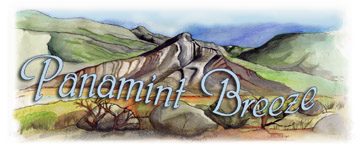 |
|
The Panamint Breeze is a newsletter for people who
love the rough and rugged deserts and mountains of
California and beyond.
Published by Ruth and Emmett Harder, it is for people who
are interested in the history of mining in the western
states; and the people who had the fortitude to withstand
the harsh elements.
It contains stories of the past and the present; stories of
mining towns and the colorful residents who lived in them;
and of present day adventurers.
Subscriptions are $20 per year (published quarterly –
March, June, September & December) Subscriptions outside the
USA are $25 per year. All previous issues are available.
Gift certificates are available also.
To subscribe mail check (made payable to Real Adventure
Publishing) along with name, address, phone number & e-mail
address to: Real Adventure Publishing, 18201 Muriel Avenue,
San Bernardino, CA 92407.
For more information about the
Panamint Breeze e-mail Ruth at: echco@msn.com |
|
|
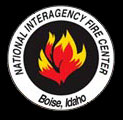 |
|
It's always FIRE
SEASON! Click the NIFC logo above to see what's burning. |
|
|
 |
|
SAVE A TREE---GET A
DIRTBAG!
Click on the bag to find
out how. |
|
|
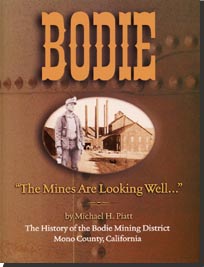 |
|
Visit Michael
Piatt's site,
www.bodiehistory.com, for the truth behind some of
Bodie's myths. |
|
|
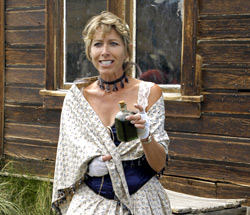 |
|
Terri
Geissinger is a Bodie area Historian, Guide and Chautauquan.
A long time resident who lives in Bodie and Smith Valley,
she is dedicated to preserving stories of the pioneer
families, miners, ranchers and teamsters. Click the photo
for information on her tours with the Bodie Foundation. |
|
|

Credo Quia Absurdum |
|
|
 |
|
Back to the past in
California City--Wimpy's!
8209
California City Blvd.,
California City, 93505 |
|
Hey
Brother,
Can 'Ya
Spare a
Job? |
|
The nation's economic
downturn has severely affected the newspaper industry. My
job of nearly 30 years was eliminated several months ago.
I'm actively looking
for full or part time job opportunities within my diverse
skill set.
If you have, or know of
any openings, please contact me through this
CONTACT
link. |
|
Explore Historic California! |
|
Not too many years ago, the family station wagon was the
magic carpet to adventure. Today, that family station wagon is likely to
be a four wheel drive sport utility vehicle or pick up truck. SUV's and
other 4x4's are one of the best selling classes of vehicles. Ironically,
industry statistics show that once purchased, few owners will dare to
drive their vehicles off the paved highway.
Click your mouse through
the
website and enjoy our armchair adventures and the histories behind them.
|
|
Bodie in Others' Words
Selected Newspaper Clippings
by Roger Vargo |
|
Bodie, in the late
1870's was full of promise. Mine shafts were driven ever deeper and
optimism was in the air.
"Are you going to Bodie?" is the
question of the day, just now; and
from all accounts Bodie appears to be the Mecca of the
despairing ones. Do not be surprised if my next letter
is dated from that town.April 4,
1979, Ukiah, California |
|
 |
|
The town of Bodie is situated on a flat between two rows
of hills. On one side is the Bodie range, where the
mines and hoisting works are located. This, though at
first sight it would appear to be, is not the town
proper. Six months ago there were about 500 buildings
and a population of some 1,500. Now there are between
3,000 and 4,000 buildings, and a population of 7,000.
There is one street over a mile long, lined on either
side with business houses.
January 25, 1879, Placerville,
California |
|
 |
The Bodie Miners' Union grew as
the mines expanded.
| The growth of the Bodie Miner's Union has been
almost unparalleled in the history of mining camps.
From a mere handful of men one year ago their
membership has grown until now they can count some
600 names on their roll-call. |
| Mountain Democrat,
May 31, 1879 |
As the town
grew, so did its desire for connection to the outside world and
its need for ever increasing supplies of wood for construction
and fuel. The Bodie Railroad ran only to the forest at Mono
Mills. It never connected to the Carson & Colorado.

 |
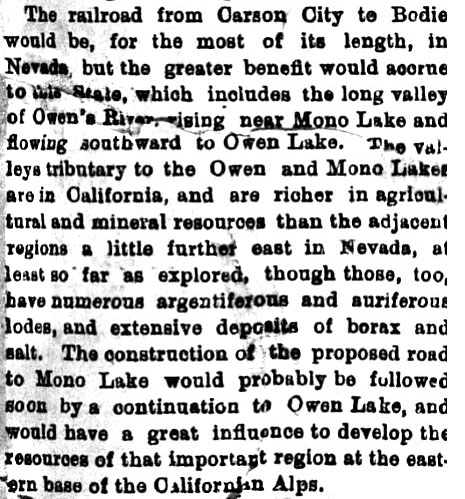
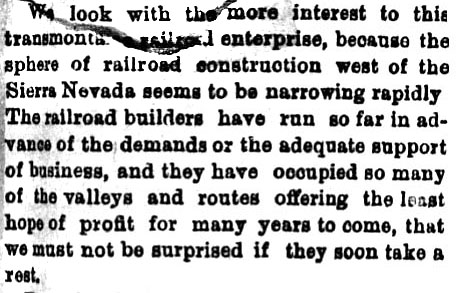
Daily Alta California,
September 16, 1878 |
| |
|
|
 |
| Daily Alta
California, May 19, 1880, San Francisco,
California |
|
 |
| |
|
RAILROAD to BODIE. — A narrow gauge
railroad is now in process of construction from the
Mound House, on the V. & T. R. R. to Bodie. A force
800 men were put to work last Monday. The road will
be pushed to completion at an early day.
Mountain
Democrat, June 5,
1880 |
| |
|
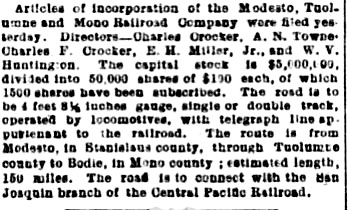 |
| Daily Alta
California, July 30, 1881 |
| |
| On Tuesday, Nov. 8th, the whistle of
a locomotive was heard in Bodie for the first time.
The narrow-gauge road to Mono Lake is about
completed, and has all the business it can do for
some time to come. |
| Mountain
Democrat,
November 19, 1881 |
Railroads weren't the only mode of
transportation that was growing in Bodie.
| There are now no less than nine stage lines
plying between Bodie and the outside world, and two
more are to be put on within a week or two. |
| Mountain Democrat,
July 30, 1880 |
But travel was never easy,
especially in the winters.
Two men started from Bodie in a wagon with six
horses about two weeks ago for Sonora. They were
caught in a snow storm, and were forced to leave
their wagon, horses and dog on the grade, unable
to proceed further with them. They arrived at
Stockton
with feet frozen, and otherwise badly used up. |
| Mountain Democrat,
January 1, 1881 |
Bodie was also a place where
violence was common.
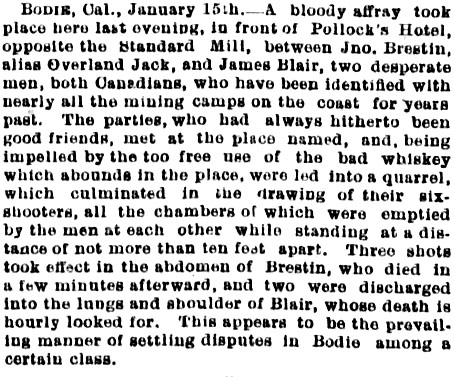 |
| Daily Alta
California,
January 18, 1878 |
|
 |
| Daily Alta California,
April 1, 1880 |
| |
|
 |
| Daily Alta California,
May 24, 1880 |
| |
|
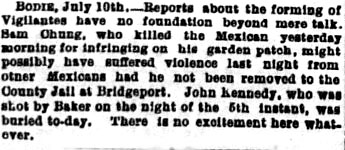 |
| Daily Alta California,
November 7,
1880 |
| |
|
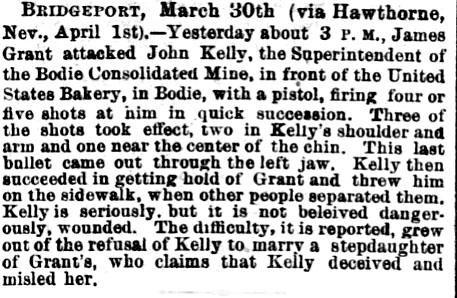 |
| Daily Alta California,
April 2, 1891 |
| |
At Bodie March 31 James Grant shot John
Kelly through the shoulder, through the arm and
through the jaw for refusing to marry Grant's
stepdaughter after having led her astray.
Kelly was superintendent of the Bodie
Consolidated mine. He refused to prosecute
Grant. |
| Mountain Democrat,
April 11, 1891 |
| |
George Montrose fought a duel with his
stepfather, A. Mathewson, on the main street at
Bodie. Eight shots were exchanged, but the only
person hurt was a bystander, Mrs.
Vierra, who was wounded in the hip. |
| Mountain Democrat,
July 27, 1895 |
Street violence wasn't the
only way to die in Bodie. The mines also claimed their share
of lives.
|
 |
| Daily Alta California,
January 6, 1878 |
| |
|
 |
| Daily Alta California,
May 31, 1879 |
| |
|
 |
| Daily Alta California,
July 19, 1890 |
And some residents died of
apparent natural causes.
|
Major
B. E. Foote, son of Henry B. Foote, the wayward and
eccentric politician, died suddenly, while sitting
in a chair at a hotel in Bodie, on the 22nd. His age
was 37. He was by profession lawyer, and man of
considerable brilliancy.
Mountain Democrat, May 31,
1878 |
Fire was an ever present
danger in Bodie. Most of the town was destroyed in two major
conflagrations (1892 and 1932). The original Standard Mill
was destroyed in 1898.
HAWTHORNE, Nev., Oct. 5--The Standard
Consolidated Mining Company's two-stamp mill at
Bodie, Cal., was totally destroyed by fire
today.
The fire started in the boiler room. The
adjoining offices and the cyanide plant were
saved. The estimated loss is $50,000; partially
insured. |
| October 5, 1898, Oakland,
California, via Hawthorne, Nevada |
 |
Life was never easy in Bodie.
The area's winters were especially harsh. As the town's
fortunes declined, so did supplies for the remaining
residents.
The Virginia Chronicle of last Tuesday says:
It
is reported that there is no flour to be had in
Bodie owing to the blocked roads. Hams and other
articles of food are entirely out, and Bodie is
now subsisting on beans, cheese and snow. |
| Mountain Democrat,
February 15, 1890 |
Through good times
and not so good times, Bodie managed to survive. Today,
about five percent of the original buildings remain in a
state of "arrested decay" as part of the California
State Parks system. Visit Bodie on Saturday, August 14,
2010, for the annual
Friends of Bodie Day
for a chance to experience the vibrancy and excitement
of years past.

BIBLIOGRAPHY
Historic newspaper clippings
from:
Newspaper Archive (www.newspaperarchive.com)
California Digital Newspaper Collection
(http://cdnc.ucr.edu/cdnc)
|
|
|
|
|
|
|
Seeing the Ghosts in the
Machines
By Chris Spiller |
|
|
If you stand near the edge of the road
at the Bodie picnic area, you will see a large iron tube atop a
small ridge at the base of the hill. This immense “tube mill” was
brought into Bodie in 1904 for use at the newly renovated Standard
Consolidated Cyanide Plant.
|
 |
|
The tube mill
arrives in Bodie in 1904.
(Emil Billeb
collection, courtesy Vickie Daniels) |
Continue to study the area around the
tube and you will spot a rock foundation. You are looking at the
remains of the Standard Mining Company’s cyanide plant. The building
burned in 1954, before Bodie became a state park.
Over 100 years ago, some of the
Standard’s most important work was conducted here. The renovations
at the plant enabled the Standard to hang on financially by
re-working old tailings.
The tube mill cannot be more closely
examined by visitors as it is within an area closed due to unstable
ground. However, the site is now a regular stop on the new Bodie
Vista Tour on Saturdays at 10 a.m. during the summer. (Check the
museum for additional Vista Tours that may be scheduled other days.)
A tube mill, which is a device for
fine grinding of already crushed ore, utilizes rocks or iron balls
in the grinding of the material.
The changes wrought by the renovation
of the plant and installation of the tube mill warranted the
attention of the Mining and Scientific Press, a mining industry
publication. The Standard was featured in a lengthy article on Sept.
23, 1905.
“The metallurgical treatment of ore
at the mines of the Standard Con. Co. at Bodie has been materially
changed within the past eight months and is now one of the most
modern in California…” states the article. Among the modern
techniques listed are “crushing in cyanide solution, further
crushing in tube mill and final treatment by the Moore process.” The
Moore process was a vacuum pump with canvas filters that allowed
treatment of tailings had not responded well to earlier cyanide
processes.
The article goes on to explain that
“irregular pebbles” from Mono Lake were at first tried in the mill.
“…but being irregular, they slide and will not roll, causing great
wear on the (tube mill) liners. Hereafter Iceland flints now being
shipped are to be used.”
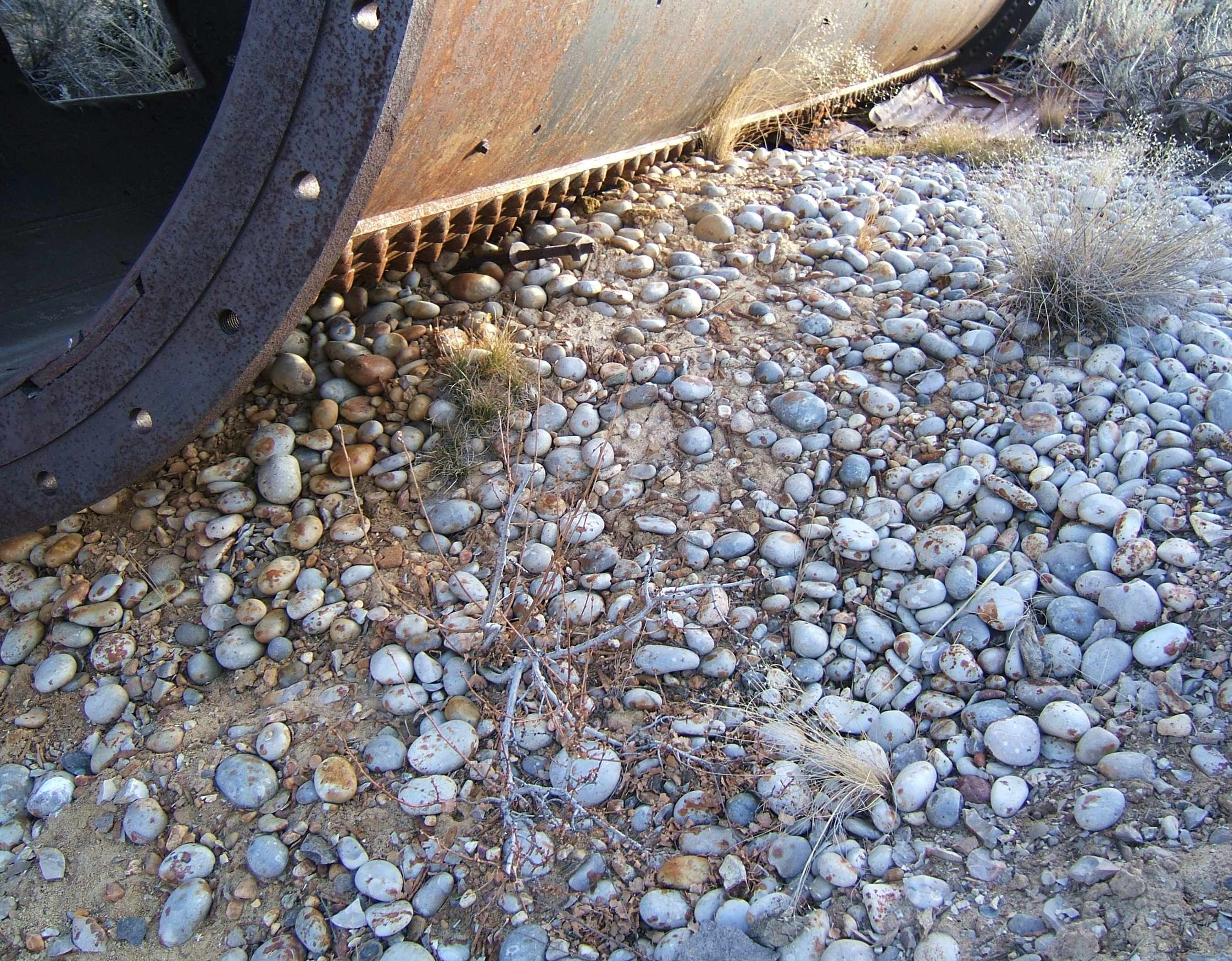 |
|
The tube mill
and flints today. |
While the article hails the staff of
the Standard for its innovative work, the months prior to the start
up of the tube mill and newly-renovated cyanide plant were full of
difficulty. The Standard’s Manager, Theodore Hoover, discussed the
problems and humorous side effects of replacing the original lining
of the tube mill in his “Memoranda: Being a Statement by an
Engineer.” The original lining of the tube mill was composed of
interlocking steel plates about 10 x 12 inches in area, by one inch
thick. The plates had a life of four or five months but the plates
would wear unevenly with plates dropping out of place frequently. A
new lining was proposed and Theodore Hoover continues the story at
this point:
“On
the first of January 1905, the new plant was ready to start. The
construction work had taken just six months, which at that time
seemed to me just twice too long. Since then further experience
shows that it was remarkable short period for a work of that
magnitude…the tube mill which we had installed for regrinding was
also an innovation in America, being the first one installed outside
South Africa, for the purpose of grinding gold ores. The
manufacturers were Allis, Chalmers & Co., and they apparently had a
very immature idea of what they were about. The liners would not
stay in and it gave us endless trouble putting them back. What was
worse, this continuous coming out was damaging to the liners and we
soon found ourselves, in midwinter, far from a railway with no tube
mill lining. We were forced to make one of wood, but this soon wore
out, and besides it introduced organic salts into the cyanide
solution, which made a tremendous froth all over the place. The
sight was comical enough to create amusement, in spite of the hard
work and worry it was also responsible for. There was froth
everywhere, in all the vats and launders and on the floor knee deep,
hip deep, chin deep. The men in the works look like a lot of water
beetles engaged in curious evolutions.”
Hoover concluded, “we finally solve
the liner and froth problems by making a new lining out of
old…Cornish pump (iron) rod straps. This entailed a lot of
hard work on the part of the blacksmith, but was finally
accomplished and was a complete success.”
|
 |
|
The tube mill
today. |
Chris Spiller is a Bodie SHP
historical interpreter. She is best known for her portrayal of Mrs.
Mildred Hoover while guiding visitors through the Standard stamp
mill.
|
|
|
|
|
|
Cerro Gordo Update
Cerro Gordo is
still Closed to Visitors
|
|
|
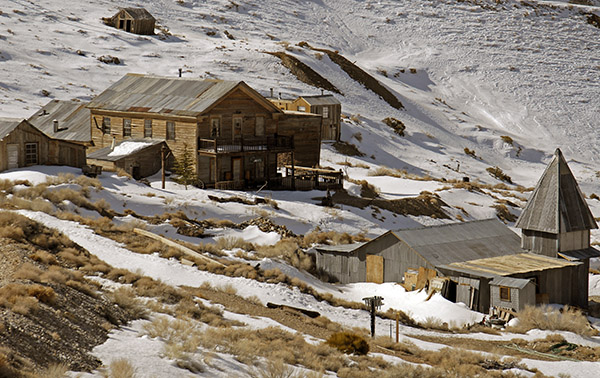 |
|
Cerro Gordo's American Hotel (center) and nearby
buildings are surrounded by a blanket of snow. |
The town of Cerro Gordo is officially closed at this time - until
further notice.
However, the road is a County Road, and pictures of the buildings
may be taken from the road.
There is absolutely no trespassing off the road. A caretaker is on
site, so please observe the no
trespassing.
Please do not hesitate to contact
Sean Patterson at:
Cell phone: 661-303-3692 or
Stay tuned to this website
or our
Facebook page for
updates on Cerro Gordo's status.

|
|
|
|
|
|
|
|
|
|
|
|
|
|
|
|
|
|
|
